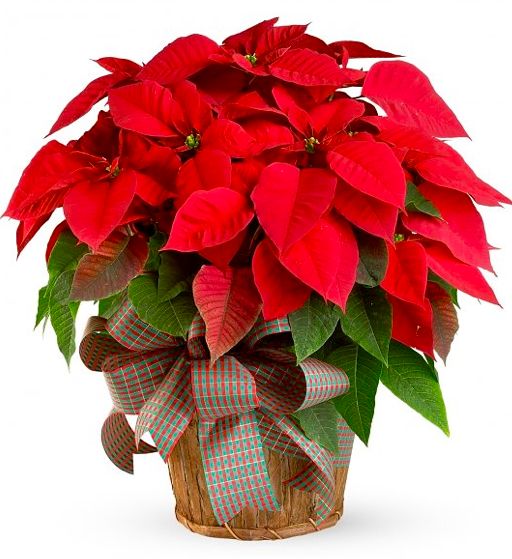
The poinsettia (/p??n's?ti?/p or /??n's?t?/) (Euphorbia pulcherrima) is a commercially important place types of the diverse spurge family. The species is indigenous to Mexico. It is specifically popular for its red and green foliage and it is widely used in Holiday floral shows. It derives its common English name from Joel Roberts Poinsett,[3] the first USA Minister to Mexico,[4] who introduced the plant to the US in 1825.
Euphorbia pulcherrima is a shrub or small tree, typically attaining a elevation of 0.6-4 metres (2 ft 0 in-13 ft 1 in). The seed bears dark green dentate leaves that measure 7-16 centimetres (2.8-6.3 in) in length. The colored bracts--which are most flaming red but can be orange often, pale green, cream, pink, white, or marbled--are recognised incorrectly as rose petals for their groupings and colors often, but are leaves actually.[citation needed] The colors of the bracts are created through photoperiodism, and therefore they might need darkness (12 hours at a time for at least five days in a row) to improve color. At the same time, the vegetation require numerous light through the full day for the brightest color. The flowers of the poinsettia are unassuming and don't attract pollinators. They are simply grouped within small yellow structures within the center of every leaf bunch, and are called cyathia. The poinsettia is native to Mexico. It really is within the crazy in deciduous exotic forests at moderate elevations from southern Sinaloa down the entire Pacific coast of Mexico to Chiapas and Guatemala. It is found in the inside in the hot also, dry forests of Guerrero seasonally, Oaxaca, and Chiapas. Information of E. pulcherrima growing in the open in Costa and Nicaragua Rica have yet to be proved by botanists. You can find over 100 cultivated varieties of poinsettia.
The Aztecs used the plant to produce red dye and as an antipyretic medication. In Nahuatl, the language of the Aztecs, the plant is named Cuitlaxochitl, meaning "flower that grows in residues or soil" Today it is known in Mexico and Guatemala as Flor de Noche Buena, meaning Christmas Eve Flower. In Spain it is known as Flor de Pascua or Pascua, indicating Easter flower. In Chile and Peru, the seed became known as Crown of the Andes. In Turkey, it is called Atat?rk's blossom because Atat?rk, the creator of the Republic, liked this bloom and made a substantial contribution to its cultivation in Turkey.[citation needed] In Hungarian, it is named Santa Claus' Rose, and it's trusted as a Christmas decoration.
The plant's association with Christmas started out in 16th-century Mexico, where legend tells of a woman, called Pepita or Maria commonly, who was too poor to give a gift for the special event of Jesus' birthday and was influenced by an angel to assemble weeds from the roadside and place them in front of the church altar. Crimson blossoms sprouted from the weeds and became beautiful poinsettias. From the 17th century, Franciscan friars in Mexico included the vegetation in their Christmas activities. The star-shaped leaf structure is thought to symbolize the Star of Bethlehem, and the red color represents the blood sacrifice through the crucifixion of Jesus. Poinsettias are popular Holiday decorations in homes, churches, offices, and elsewhere across North America. They are available in good sized quantities from grocery, drug, and hardware stores. In the United States, Dec 12 is National Poinsettia Day.
Christmas Poinsettias Poinsettias add christmas
poinsettias red poinsettia christmas cottage red christmas christmas


Tidak ada komentar:
Posting Komentar